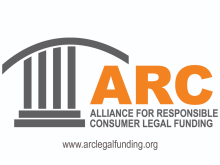The American civil justice system is designed to provide accountability when someone is harmed through negligence or misconduct. It is supposed to ensure that people who are injured have a chance to be made whole, and that wrongdoers are held responsible. But for many individuals, justice takes time. And time, as anyone living paycheck to paycheck knows, can be brutally expensive.
That’s where Consumer Legal Funding (CLF) comes in. CLF provides financial support to individuals who are waiting for the resolution of a legal claim, giving them the ability to meet ordinary household expenses while their case works its way through the courts. Yet, some critics have tried to lump CLF into a broader narrative about a supposed “tort tax”—a claim that litigation generally raises costs for businesses, insurers, and ultimately consumers.
What Consumer Legal Funding Actually Does
To understand why CLF isn’t a “tort tax,” it’s important to understand what it actually is—and what it is not.
When someone is injured in a car accident, were wrongfully convicted or suffered at the hands of another, the legal process to recover damages can take months or even years. In the meantime, bills don’t stop. Rent, mortgage payments, utilities, childcare, and medical expenses continue to come due. If the injured person can’t work, their financial situation can quickly spiral.
Consumer Legal Funding steps in by offering a non-recourse funds against a potential settlement. That means:
- If the plaintiff wins or settles, they repay the funds plus agreed-upon fees.
- If the plaintiff loses, they owe nothing.
This is critical: CLF is not a loan. Unlike traditional lending, there is no recourse if the plaintiff’s case fails. The funding is also strictly limited to personal, household expenses—it cannot be used to pay lawyers, litigation costs, or court fees. In states that regulate CLF, this prohibition is written into law.
In short, Consumer legal funding finances lives, not litigation.
The Myth of the “Tort Tax”
The “tort tax” concept has been a rallying cry for tort reform advocates for decades. It suggests that litigation adds hidden costs to the economy—costs that businesses pass along in the form of higher prices or insurance premiums.
While the tort tax itself is hotly debated, what’s clear is that Consumer Legal Funding doesn’t fit within that framework. Let’s break down why.
1. CLF Doesn’t Create Lawsuits
One of the biggest misconceptions is that funding encourages people to file lawsuits they otherwise wouldn’t. But CLF providers only provide funds to individuals who already have a case with legal representation. Personal injury attorneys work on contingency, meaning they only get paid if the client wins. Lawyers don’t take frivolous cases, because there’s no incentive to spend time and resources on claims that won’t succeed.
2. CLF Doesn’t Inflate Damages
Critics sometimes argue that funding allows plaintiffs to “hold out” for bigger settlements, inflating overall payouts. But this argument gets it backwards.
Without funding, many plaintiffs are forced to accept lowball offers because they need money immediately. With funding, they have the breathing room to wait for a settlement that more accurately reflects their injuries and losses. This doesn’t artificially inflate damages—it ensures fairness by preventing defendants from exploiting financial desperation.
In fact, damages are determined by evidence: medical records, lost wages, expert testimony, and jury decisions. The presence of CLF doesn’t change the evidence or the legal standards.
3. CLF Costs Are Private, Not Public
Finally, there’s the question of cost. Critics suggest CLF somehow burdens insurers or society at large. But repayment comes solely from the plaintiff’s own recovery. No costs are shifted to defendants, insurers, or consumers in general.
In other words, CLF is a private transaction between an individual and a funder. There’s no mechanism by which it could raise insurance rates or product prices.
The Real Driver of Costs: Delay
If we’re looking for hidden costs in the civil justice system, the real culprit is delay. Insurance companies are notorious for stalling claims, knowing that time works in their favor. The longer they delay, the more likely a financially strapped plaintiff is to accept a low settlement.
These tactics not only hurt families but also reduce accountability for negligent actors. Dangerous drivers, careless landlords, and negligent businesses face fewer consequences when claims are settled for pennies on the dollar.
Consumer Legal Funding helps fix this imbalance. By giving plaintiffs financial stability, it removes the pressure to settle prematurely. That makes the system more just—and arguably more efficient—by ensuring cases are resolved on their merits, not on the plaintiff’s level of desperation.
A Human Face on the Issue
Consider a real-world scenario. A single mother is injured in a car accident caused by a reckless driver. She can’t work, and her bills are piling up. The insurance company offers a settlement that barely covers her initial hospital visit.
Without CLF, she might accept the offer, because she needs to keep a roof over her kids’ heads. With CLF, she can cover rent and groceries, giving her lawyer time to negotiate a settlement that reflects the full extent of her injuries, lost income, and long-term needs.
The difference is enormous—not just for her, but for justice. The reckless driver is held accountable. The settlement reflects the true harm done. And society sends a message that negligent behavior has consequences.
That is not a tort tax. That is access to justice.
Addressing the Critics
Opponents of CLF often recycle the same talking points. Here’s why they don’t stand up:
- “CLF fuels frivolous lawsuits.” False. Lawyers won’t take frivolous cases on contingency, and funders won’t provide funds on cases that are unlikely to succeed.
- “CLF inflates damages.” False. Damages are based on evidence, not on whether a plaintiff used funding. Funding prevents unfair settlements, it doesn’t increase payouts beyond what’s justified.
- “CLF imposes hidden costs on society.” False. CLF costs are private and only repaid from a plaintiff’s recovery. No one else bears the burden.
A Better Way to See It
Instead of viewing CLF as part of a tort tax, policymakers should see it for what it really is: a tool of fairness.
It ensures that justice is not only for the wealthy or financially stable. It levels the playing field between ordinary people and the massive corporations or insurers they often face in court.
CLF doesn’t undermine the civil justice system—it strengthens it, by making outcomes less dependent on financial imbalance and more dependent on truth and accountability.
Conclusion
The “tort tax” is a powerful rhetorical device, but it doesn’t apply to Consumer Legal Funding. CLF doesn’t create lawsuits, inflate damages, or impose hidden costs. Instead, it addresses a very real problem: the financial vulnerability of injured people waiting for justice.
By providing stability, CLF ensures plaintiffs can pursue fair settlements, hold wrongdoers accountable, and keep their households afloat in the meantime.
Far from being a tax, it is a lifeline. Far from undermining justice, it makes justice possible.
Consumer Legal Funding isn’t part of the problem. It’s part of the solution.




 />i
/>i

